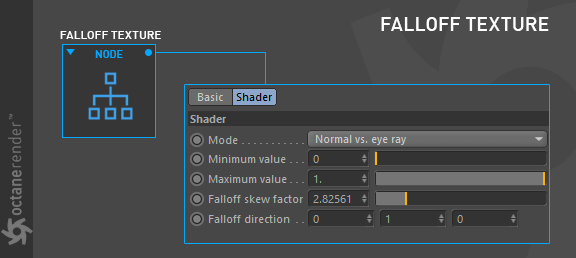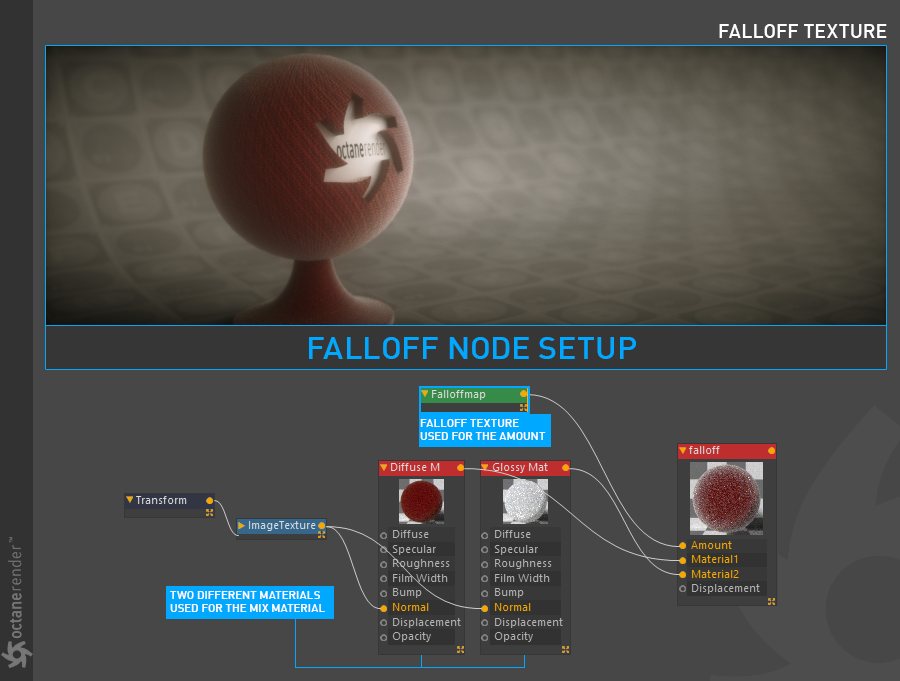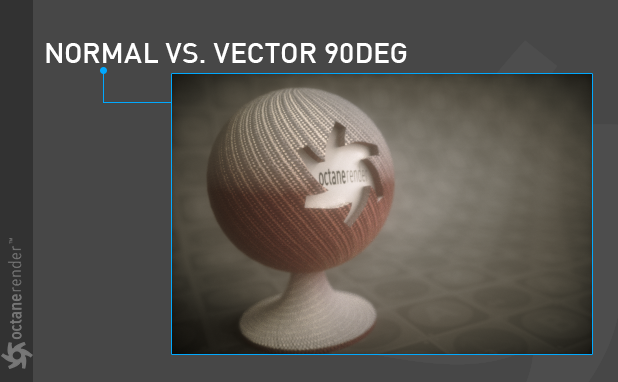
The Falloff Texture Generator produces a Falloff Texture node, which is used to control the blend of two materials depending on the viewing angle of the material's geometry. Before Octane V3.08, this node was used to create fake fresnel. However, the use of this node is not necessary when Fresnel equations with 3.08 begin to give correct results. Octane now renders the fresnel effect as it should be during the material creation. Let's continue our explanations with this warning in mind.

How To Use
Open the Node editor and prepare the setup as you see in the picture below. In this setup, 2 different materials are linked to "Mix materialUsed to mix any two material types." and amount is controlled by falloff. As you can see in the picture, the whiteness towards the edges is actually a classic fresnel appearance. With the help of the Falloff mode value, this fake fresnel view will adapt itself according to the camera angle. In the below example "Normal vs. eye ray" is used as Falloff Mode. We will explain these options at the end of the page.
You can use the Falloff texture for other purposes. For example, it can be used to cover your objects with "dust", or it can be used on fabrics like velvet. We recommend you to use it mostly for DiffuseAmount of diffusion, or the reflection of light photons at different angles from an uneven or granular surface. Used for dull, non-reflecting materials or mesh emitters. materials. Using the falloff node may not be accurate in case of GlossyThe measure of how well light is reflected from a surface in the specular direction, the amount and way in which the light is spread around the specular direction, and the change in specular reflection as the specular angle changes. Used for shiny materials such as plastics or metals. and SpecularAmount of specular reflection, or the mirror-like reflection of light photons at the same angle. Used for transparent materials such as glass and water. materials because they produce realistic IOR and Fresnel.

Falloff Mode
There are 3 falloff modes here. Let's explain:
Normal vs. Eye Ray
This is the default mode where the falloff is calculated from the angle between the surface normal and the eye ray. This mode is more commonly used for reflections and the falloff color range affects faces directly in front of the view and gradually falls at angled faces towards the sides as it falls away from the straight on viewing angle. Therefore the Falloff Direction parameter does not apply.

Normal vs. Vector 90deg
The falloff is calculated from the angle between the surface normal and the specified direction vector maxing out at 90 degrees. This is similar to the default mode except that it maintains the effect of the color range according to the Falloff Direction x/y/z.

Normal vs. Vector 180deg
The falloff is calculated from the angle between the surface normal and the specified direction vector maxing out at 90 degrees. This is similar to the default mode except that it maintains the effect of the color range according to the Falloff Direction x/y/z.

Minimum and Maximum Value
The relative amount of the Minimum and Maximum values that are at an angle to the straight on view. 0.1 will lead to almost complete coverage by the grazing value regardless of viewing angle, where as 1 will lead to almost complete coverage by the normal value.

Falloff Skew Factor
This parameter is used to balance the influence of the normal and grazing angles. A low value means that the influence of the grazing angle is stronger - any textures controlled by the falloff Maximum value will cover more of the surface. Higher Skew Factor settings result in a stronger influence of the normal angle - any textures controlled by the Minimum value will cover more of the surface.
Falloff Direction
The direction vector that is used by the Normal vs. Vector 90deg and Normal vs. Vector 180deg modes. For most materials, the fresnel effect (the default mode) is usually correct while falloff direction is used for exceptional cases which can be adjusted relative to the camera. Changing the rotation of the object will not change the orientation of the falloff direction.